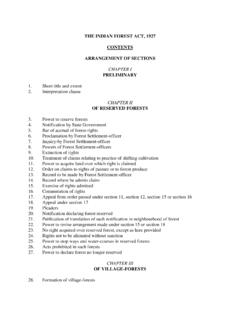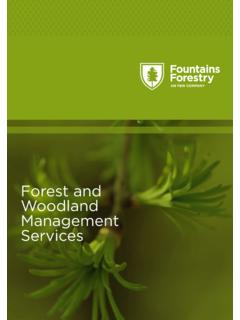Transcription of South Africa Forest Policy - Food and Agriculture Organization
1 [ DWAF Home Page | Forestry Home ]. SUSTAINABLE. Forest DEVELOPMENT IN South . Africa . THE Policy . OF THE. GOVERNMENT OF NATIONAL UNITY. WHITE PAPER. MINISTRY OF WATER AFFAIRS AND FORESTRY, PRETORIA, South Africa . TABLE OF CONTENTS. Preface 1. THE BACKGROUND TO A NEW Forest Policy . The scope of Forest Policy in South Africa The role of forestry in the RDP. The process of developing Policy for the Forest sector in South Africa The issues facing the Forest sector in South Africa The state of natural Forest and woodland resources in South Africa today The forestry sector and rural communities Rural energy requirements The forestry workforce Land claims in forestry areas Community forestry Industrial forestry and its contribution to the country's economy Industries based on wood Meeting the country's need for industrial wood Sustainability of industrial forests Forestry and water supplies Industrial forestry and the conservation of biodiversity Forestry and land-use planning in South Africa International conventions and concerns Government involvement in forestry in South Africa Advanced education and training for forestry Research, technology development and innovation 2.
2 THE NEW Forest Policy . Principles Overall goal The Forest Policy in relation to natural resources management in South Africa Working conditions The Policy for industrial forestry The Policy for community forestry Conserving natural forests and woodlands Global concerns for sustainable Forest development South Africa in the Southern African Development Community Bilateral international relations in forestry 3. TAKING Policy INTO PRACTICE. Formulation of a new law Prerequisites for applying Policy The role of central government SAFCOL: the role of government in industrial forestry Managing the transition of Forest resources of the former homelands The role of provincial government The role of local government The role of the private sector Government's relationship with the community The role of the National Forestry Advisory Council Strategy and action planning Women in forestry Research, technology, and innovation Education and training 4.
3 CONCLUSION. PREFACE. This White Paper on Forest Policy is the second such document produced by my Department. As with its predecessor, the White Paper on Water Supply & Sanitation Policy , it is intended to provide the Forestry Industry and the general public with a clear view of the Policy which the new Administration intends to adopt. In keeping however with our expressed intention to ensure open and transparent debate, comment and criticism on the contents of this document are welcomed. Policy is not holy writ. It can and will be modified when a clear need to do so is shown to be in the national interest. The Policy directions which you will read clearly break with the narrow and rather parochial concerns of the past. Our new Government is concerned with far wider issues that impact on the lives and wellbeing of all of our people, and new forestry Policy must reflect these concerns.
4 We of course cover the direct and immediate Policy requirements of historical and traditional forestry and the industries which it has spawned, as will be apparent from the Table of Contents. We also, however, cover another sector hitherto largely neglected. Forestry in South Africa , and everywhere else where it is consciously practised, has at least two main streams of endeavour. The older of these is the protection of the natural Forest resource, it being clearly recognised as being a part of the natural heritage. Out of this has grown the science of commercial forestry to feed the voracious appetite of the world's growing populations for wood as a raw material. We are surrounded by wood from the cradle to the grave. Timber and paper are irreplaceable in our lives. There is a third stream in South Africa , at present weak and seeking its optimum flow-path, but of major importance in South Africa 's proper and harmonious development.
5 It is the new stream of community forestry and agroforestry, supplementing commercial forestry by endeavours nearer to the people's needs. It aims to improve the living conditions of all our people through projects such as school nurseries, urban and peri-urban tree plantings, individual fruit and shade tree plantings and transporting surplus wood to needy areas. It is common cause that the most deprived sections of our people are those in rural areas. They have little or no land, little or no fuel, little or no income, and struggle daily with the burden of poverty. Forestry is rurally based and there is a natural link between it and the rural population. It can provide employment, building materials, fuel and craft materials. It can provide opportunity and hope and can add dignity to the environment. This is the broad aim of the Policy outlined in this White Paper to weld together the three strains of Indigenous Forest Management, commercial forestry and community forestry.
6 The overall goal of Government is to promote a thriving Forest sector, utilised to the lasting and sustained benefit of the total community, and developed and managed to protect and to improve the environment. There are also important over-riding concerns which are addressed. We believe that, regardless of the ownership of the Forest land, be it state or private or communal, we must move towards fostering a spirit of stewardship of this for the nation and for posterity. We are dealing with an asset that brings with ownership wider responsibilities than the narrow objectives that have been routinely accepted. Inherent in this philosophy of stewardship is the concept of sustainability which is a recurring theme in this paper. Sustainability is of course the essential norm for all of the broad spectrum of endeavours that are part of forestry.
7 There should no longer be exploitation of any of our assets, human or material, for an ephemeral advantage which ignores the future. My Department has no formal jurisdiction over many of these matters, but it does, by Act of Parliament, have a clear responsibility to ensure the wellbeing of the Forest industry. We interpret this to include the wider reaches of that industry which are covered in this document. That is the background against which it is presented. The Policy will be applied and monitored by a newly reconstituted Department of Water Affairs and Forestry. The amalgamation of all water and forestry related activities and personnel of the eleven old "homelands" under the national administration will effectively treble the size of the Department. Because of this and the new and different functions which it will have to undertake to satisfy the new Policy directions of water affairs, sanitation and forestry and the necessity that these should be integrated into the Reconstruction and Development Programme, a new institutional framework is being developed.
8 This transformation will take some time but I am confident that the new Department will achieve our Policy objectives within a reasonable period. This White Paper is based to a very considerable degree on the extensive consultation process, beginning with the preparations for the National Forest Conference which I convened over a year ago. Many people from all sectors of the wider forestry industry have contributed to the debate. I must express my deep gratitude to them all, and especially to the small core of dedicated officials and individuals who have produced the documents which have reached the public. They have made my task easier and indeed more comfortable in that I am secure in the knowledge that most major concerns of all who have an interest in our industry have been addressed. Prof. Kader Asmal, MP, Minister of Water Affairs and Forestry 1.
9 BACKGROUND TO A NEW. Forest Policy . The scope of Forest Policy in South Africa Contrary to the traditional view of forestry as the science of managing forested land, forestry today is about the relationships between people and the resources provided by the Forest . It includes the use and husbandry of the wood, fruits and other products that come from trees, as well as the wildlife that dwell in the Forest . Other factors of importance are the environmental, aesthetic and cultural values of forests and woodlands. A Forest Policy must therefore deal with the scope of these relationships between people and Forest resources. It cannot be confined narrowly to matters relating to Forest industries, or to a restricted concept of a Forest . World Forest policies, such as those contained in the Forestry Principles of Agenda 21 (a comprehensive global programme for sustainable development arising from the Earth Summit in Rio de Janeiro in June 1992), refer to "forests of all kinds".
10 Government Policy in South Africa is formulated to include "forests of all kinds", that is, the indigenous forests, where trees grow with their crowns virtually intertwined, natural woodlands, where tree cover may be as little as 10%, plantation, and community forests. This accords with the Food and Agriculture Organisation's (FAO) definition of forests. Consequently, the Forest Policy for this country addresses all components of the Forest sector, indigenous forests and woodlands, industrial forestry and community forestry. The text distinguishes between these where required. This is a change from the past which has significant implications. This is made clear later in Section 3. This Forest Policy defines the role of Government in dealing with the Forest sector. It is set within a frame of overarching policies, including macroeconomic, trade, industrial development, and human resources development policies.

















